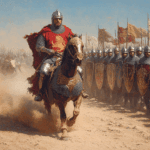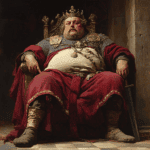
Eleanor of Aquitaine was one of the most extraordinary figures of the medieval period, renowned for her intelligence, political acumen, and indomitable spirit. As Duchess of Aquitaine, Queen of France, and later Queen of England, Eleanor’s life was marked by incredible political intrigue and family drama.
Early Life and Rise to Power
Eleanor was born around 1122 in Bordeaux, Aquitaine, to William X, Duke of Aquitaine, and Aénor de Châtellerault. As heiress to one of the largest and wealthiest domains in Europe, she became an immensely desirable match upon her father’s death in 1137. At just fifteen years old, Eleanor inherited the duchy of Aquitaine, a region encompassing much of southwestern France. Her inheritance made her one of the wealthiest women in Europe and set the stage for her future as a queen.
Queen of France: Conflict
Later that same year, Eleanor married Prince Louis of France, son of King Louis VI. Within months of their wedding, Louis VI passed away, making Eleanor Queen of France alongside her husband Louis VII. They were crowned on Christmas Day in 1137.

Eleanor’s marriage to Louis VII proved tumultuous. Though they had two daughters—Marie and Alice—their inability to produce a male heir caused tension. Eleanor’s strong-willed personality clashed with Louis’s piety and reserved nature.
Taking the Cross and Assembling Her Retinue
Eleanor joined the crusade not merely as Louis’s queen but as a powerful ruler in her own right. At Easter 1146, she took the cross alongside Louis at Saint-Denis after Pope Eugene III called for a crusade to rescue the Crusader States threatened by Muslim forces. Eleanor’s involvement was strategic; her presence helped rally support from Aquitainian nobles who owed her allegiance rather than Louis. She assembled a retinue that reportedly included 300 armed women who were said to have dressed as Amazons, a detail that scandalized contemporaries.
The Journey and Early Challenges
The crusade began with high hopes but quickly descended into logistical chaos. The French army faced constant harassment from Turkish forces as they marched through Asia Minor. Disaster struck during the crossing of Mount Cadmus in January 1148. Eleanor’s vassal, Geoffrey de Rancon, led the vanguard ahead of the main army despite orders to wait at a designated camp. This decision left the main column vulnerable to ambush by Turkish forces, resulting in heavy losses. Eleanor’s association with Geoffrey led many to blame her for this debacle, further tarnishing her reputation.
Conflict in Antioch
The crusaders eventually reached Antioch, where Eleanor’s uncle, Raymond of Poitiers, ruled as Prince. Raymond sought Louis’s support for an assault on Aleppo to secure Edessa, the original goal of the crusade. Eleanor backed her uncle’s strategy, but Louis insisted on continuing to Jerusalem for personal pilgrimage reasons rather than military objectives. Tensions escalated when rumors spread about Eleanor’s close relationship with Raymond, leading Louis to suspect infidelity—a claim historians generally dismiss as unfounded.
Eleanor openly defied Louis by expressing her desire to stay in Antioch and support Raymond’s plans. Her defiance marked a turning point in their marriage and highlighted her independent spirit. Ultimately, Louis forced her to leave Antioch with him under strained circumstances.

The Aftermath
The Second Crusade ended in failure, culminating in the disastrous siege of Damascus in 1148. Eleanor and Louis returned to Europe separately, their marriage irreparably damaged by their conflicts during the crusade. Eleanor’s behavior during the crusade had sparked rumors and jealousy from Louis. In 1152, their union was annulled on grounds of consanguinity—a convenient excuse that allowed Eleanor to retain control over Aquitaine.
Queen of England: Marriage to Henry II
Eleanor wasted no time after her annulment from Louis VII. Within two months, she married Henry Plantagenet (later Henry II), Count of Anjou and Duke of Normandy. In 1154, Henry ascended to the English throne as King Henry II, making Eleanor Queen of England. This union created the Angevin Empire—a vast realm stretching from England to western France—and solidified Eleanor’s power as a political force.
Eleanor bore Henry eight children—five sons and three daughters—including future kings Richard I (Richard the Lionheart) and John Lackland.
Eleanor’s marriage to Henry II had initially been a union of power and ambition, but over time it deteriorated due to Henry’s infidelities and his tight control over Eleanor’s hereditary lands in Aquitaine. Aquitaine, which Eleanor brought into their marriage, was a vast and wealthy region she had ruled independently before their union. However, Henry retained control over its finances and military, leaving Eleanor increasingly frustrated and sidelined.
By the early 1170s, familial discord intensified. Eleanor’s sons—Henry the Young King, Richard (later known as Richard the Lionheart), and Geoffrey—were also discontented with their father’s refusal to grant them independent authority over their inheritances. The immediate trigger for the revolt came when Henry II decided to allocate castles that were part of the Young King’s inheritance to his youngest son, John. This decision alienated the Young King and pushed him into open rebellion, supported by Eleanor and his brothers.

Eleanor’s Role in the Revolt
Eleanor played a pivotal role in organizing the rebellion. She encouraged her sons to rise against their father and rallied support among her vassals in Aquitaine. Her involvement was motivated not only by personal grievances but also by a desire to reclaim control over her lands and secure power for her sons. Eleanor’s alliance with Louis VII of France—her former husband—further strengthened the rebellion. Louis supported Eleanor’s sons, creating a formidable coalition against Henry II.
The revolt was widespread, involving attacks on multiple fronts. Louis VII invaded Normandy from the south, while other allies attacked from Brittany and Scotland. Eleanor attempted to join her sons in Paris but was intercepted by Henry’s troops and captured en route. Her capture marked the end of her active involvement in the rebellion.
Outcome of the Revolt
Despite its initial momentum, the revolt ultimately failed. Henry II proved to be a skilled military strategist and quickly suppressed the uprisings across his territories. In England, rebel forces were defeated at key battles like Fornham and Alnwick. By September 1174, Eleanor’s sons reconciled with their father after surrendering. Eleanor herself remained imprisoned for over fifteen years, confined in various castles until Henry’s death in 1189.

Regency and Later Years
After Henry II’s death in 1189, Eleanor was released from captivity by her son Richard I upon his ascension to the throne. She played a critical role during Richard’s reign as regent while he embarked on the Third Crusade. When Richard was captured on his journey home from crusading, Eleanor worked tirelessly to secure his ransom—a testament to her unwavering loyalty as a mother.
In her later years, Eleanor continued to wield influence over European politics. She brokered alliances through strategic marriages for her children and grandchildren—earning her the moniker “grandmother of Europe.” Even into old age, she traveled extensively across Europe to manage her family’s affairs.

Legacy
Eleanor died in 1204 at Fontevraud Abbey at approximately 80 years old—a remarkable age for someone who had lived through such tumultuous times. Her life exemplifies resilience; she navigated political upheaval while shaping European history through diplomacy, motherhood, and cultural patronage.
In sum, Eleanor of Aquitaine was far more than a queen consort; she was a trailblazer who reshaped medieval Europe through sheer force of will—a woman ahead of her time whose influence continues to resonate centuries later.




